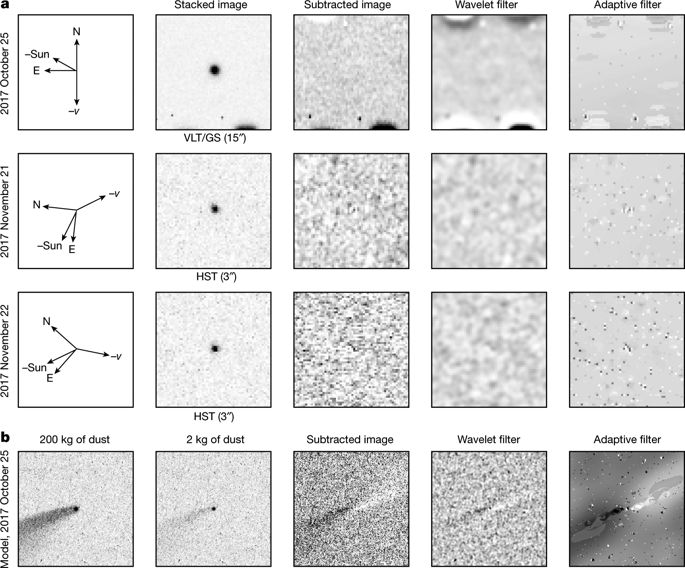Our official English website, www.x-mol.net, welcomes your
feedback! (Note: you will need to create a separate account there.)
Non-gravitational acceleration in the trajectory of 1I/2017 U1 (‘Oumuamua)
Nature ( IF 50.5 ) Pub Date : 2018-06-27 , DOI: 10.1038/s41586-018-0254-4 Marco Micheli , Davide Farnocchia , Karen J. Meech , Marc W. Buie , Olivier R. Hainaut , Dina Prialnik , Norbert Schörghofer , Harold A. Weaver , Paul W. Chodas , Jan T. Kleyna , Robert Weryk , Richard J. Wainscoat , Harald Ebeling , Jacqueline V. Keane , Kenneth C. Chambers , Detlef Koschny , Anastassios E. Petropoulos
Nature ( IF 50.5 ) Pub Date : 2018-06-27 , DOI: 10.1038/s41586-018-0254-4 Marco Micheli , Davide Farnocchia , Karen J. Meech , Marc W. Buie , Olivier R. Hainaut , Dina Prialnik , Norbert Schörghofer , Harold A. Weaver , Paul W. Chodas , Jan T. Kleyna , Robert Weryk , Richard J. Wainscoat , Harald Ebeling , Jacqueline V. Keane , Kenneth C. Chambers , Detlef Koschny , Anastassios E. Petropoulos

|
Abstract‘Oumuamua (1I/2017 U1) is the first known object of interstellar origin to have entered the Solar System on an unbound and hyperbolic trajectory with respect to the Sun1. Various physical observations collected during its visit to the Solar System showed that it has an unusually elongated shape and a tumbling rotation state1–4 and that the physical properties of its surface resemble those of cometary nuclei5,6, even though it showed no evidence of cometary activity1,5,7. The motion of all celestial bodies is governed mostly by gravity, but the trajectories of comets can also be affected by non-gravitational forces due to cometary outgassing8. Because non-gravitational accelerations are at least three to four orders of magnitude weaker than gravitational acceleration, the detection of any deviation from a purely gravity-driven trajectory requires high-quality astrometry over a long arc. As a result, non-gravitational effects have been measured on only a limited subset of the small-body population9. Here we report the detection, at 30σ significance, of non-gravitational acceleration in the motion of ‘Oumuamua. We analyse imaging data from extensive observations by ground-based and orbiting facilities. This analysis rules out systematic biases and shows that all astrometric data can be described once a non-gravitational component representing a heliocentric radial acceleration proportional to r−2 or r−1 (where r is the heliocentric distance) is included in the model. After ruling out solar-radiation pressure, drag- and friction-like forces, interaction with solar wind for a highly magnetized object, and geometric effects originating from ‘Oumuamua potentially being composed of several spatially separated bodies or having a pronounced offset between its photocentre and centre of mass, we find comet-like outgassing to be a physically viable explanation, provided that ‘Oumuamua has thermal properties similar to comets.‘Oumuamua—the first known interstellar object to have entered the Solar System—is probably a comet, albeit with unusual dust and chemical properties owing to its origin in a distant solar system.
中文翻译:

1I/2017 U1 ('Oumuamua) 轨迹中的非重力加速度
摘要'Oumuamua (1I/2017 U1) 是第一个以相对于 Sun1 的无约束双曲线轨迹进入太阳系的星际起源天体。在访问太阳系期间收集的各种物理观测表明,它具有异常拉长的形状和翻滚的旋转状态 1-4 并且其表面的物理特性类似于彗核的物理特性 5,6,尽管它没有显示出彗星存在的证据活动 1、5、7。所有天体的运动主要受重力控制,但彗星的轨迹也可能受到由于彗星放气而产生的非重力影响 8。因为非重力加速度至少比重力加速度弱三到四个数量级,检测与纯重力驱动轨迹的任何偏差需要在长弧上进行高质量的天体测量。因此,仅对小天体种群的有限子集测量了非重力效应。在这里,我们报告了对 'Oumuamua 运动中的非重力加速度的 30σ 显着性检测。我们分析来自地面和轨道设施的广泛观测的成像数据。该分析排除了系统偏差,并表明一旦模型中包含代表与 r-2 或 r-1(其中 r 是日心距离)成比例的日心径向加速度的非重力分量,就可以描述所有天体测量数据。在排除太阳辐射压力、阻力和摩擦力、与太阳风的相互作用后,高度磁化的物体,
更新日期:2018-06-27
中文翻译:

1I/2017 U1 ('Oumuamua) 轨迹中的非重力加速度
摘要'Oumuamua (1I/2017 U1) 是第一个以相对于 Sun1 的无约束双曲线轨迹进入太阳系的星际起源天体。在访问太阳系期间收集的各种物理观测表明,它具有异常拉长的形状和翻滚的旋转状态 1-4 并且其表面的物理特性类似于彗核的物理特性 5,6,尽管它没有显示出彗星存在的证据活动 1、5、7。所有天体的运动主要受重力控制,但彗星的轨迹也可能受到由于彗星放气而产生的非重力影响 8。因为非重力加速度至少比重力加速度弱三到四个数量级,检测与纯重力驱动轨迹的任何偏差需要在长弧上进行高质量的天体测量。因此,仅对小天体种群的有限子集测量了非重力效应。在这里,我们报告了对 'Oumuamua 运动中的非重力加速度的 30σ 显着性检测。我们分析来自地面和轨道设施的广泛观测的成像数据。该分析排除了系统偏差,并表明一旦模型中包含代表与 r-2 或 r-1(其中 r 是日心距离)成比例的日心径向加速度的非重力分量,就可以描述所有天体测量数据。在排除太阳辐射压力、阻力和摩擦力、与太阳风的相互作用后,高度磁化的物体,









































 京公网安备 11010802027423号
京公网安备 11010802027423号